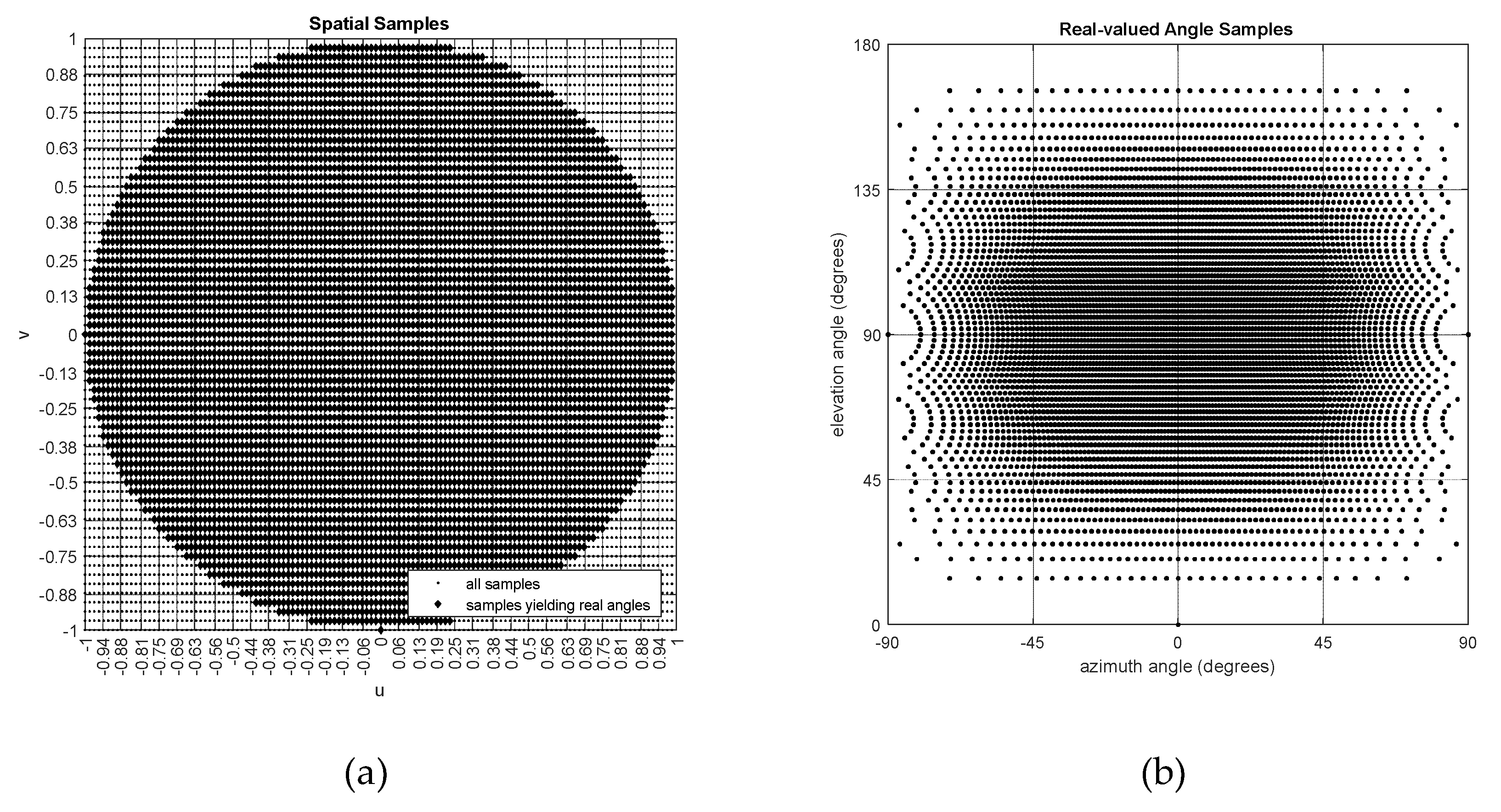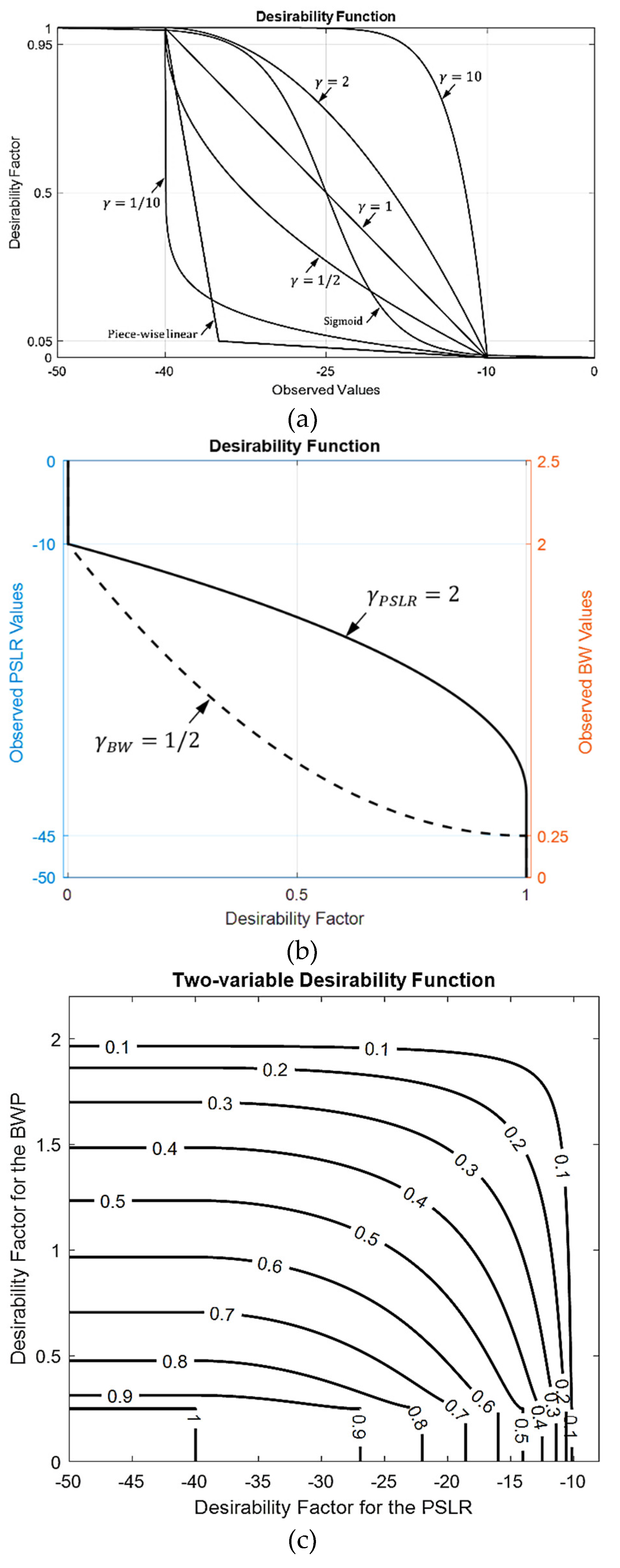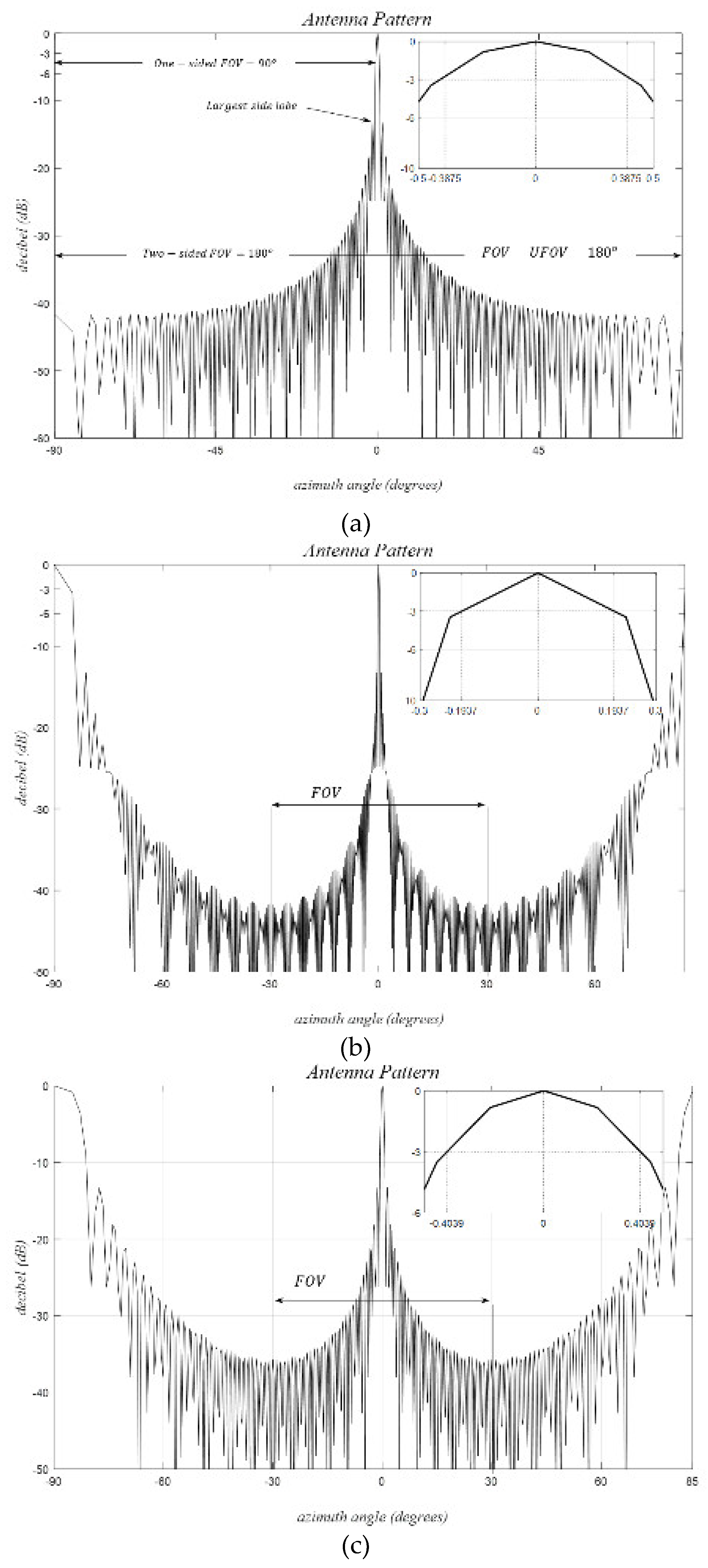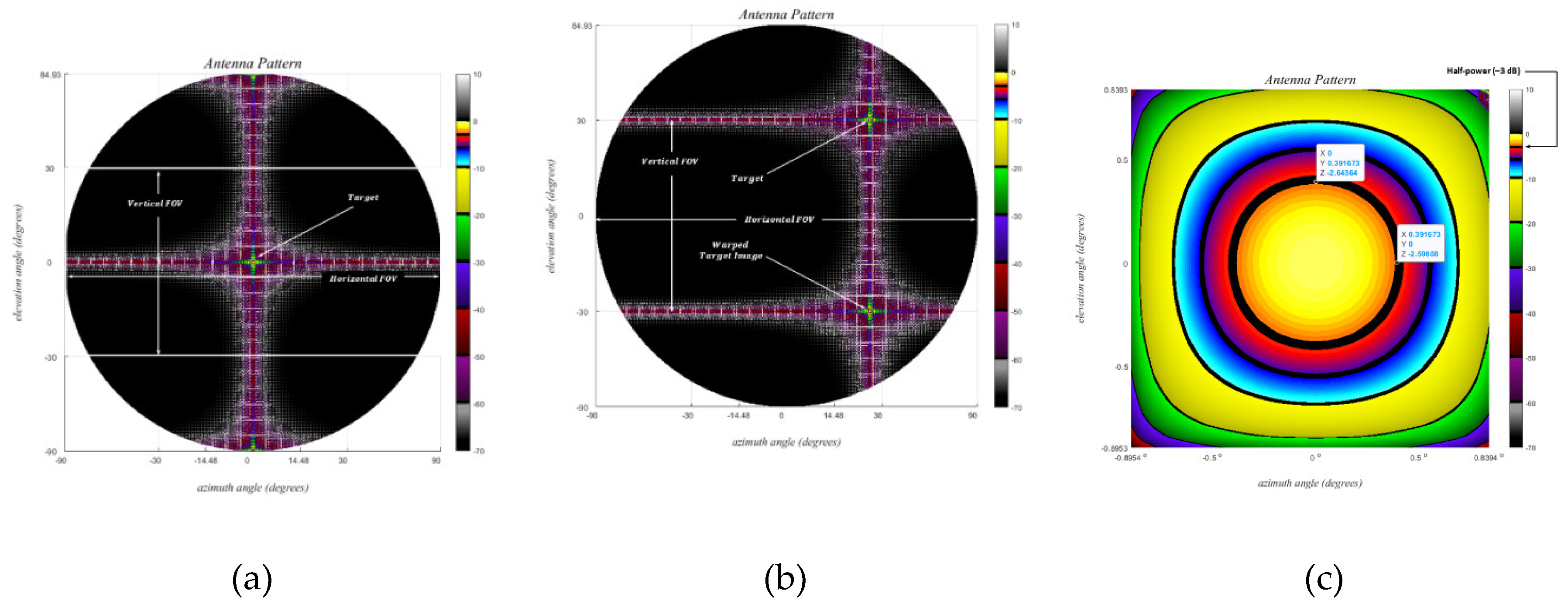Submitted:
25 July 2024
Posted:
26 July 2024
You are already at the latest version
Abstract
Keywords:
1. Introduction
| Aperture Loss and Beamwidth Spreading Factors | |
| and | Beamforming vector and matrices |
| Reference phase at the origin | |
| Calibration matrices; standard and for the sparse array formulation | |
| Inter-element spacing, its value normalized to one wavelength and incremental spacing value | |
| , | The desirability functions for the LTB and STB cases |
| Antenna element gain factors | |
| FOV, uFOV | Operational field of view (FOV) and the usable FOV |
| Direction of the t’th target in spherical coordinates | |
| Beamforming output | |
| Wavevector | |
| Number of transmitter, receiver and virtual receiver elements | |
| Sparse array element order number and the total number of virtual elements | |
| Oversampling ratios for the field domain | |
| Far-field received pattern | |
| Steering vectors | |
| Displacement vectors for the field point, TX and RX | |
| Radar cross-section for the t’th target | |
| Thinning/sparsity ratio | |
| T | Number of targets |
| Directional cosine terms, for the field domain | |
| Expected observation range for the variable | |
| Field point based on the ISO/SAE coordinate system. | |
| Source coordinates where the aperture is located on the surface. | |
| Transmitter and receiver coordinates on the aperture | |
| Antenna aperture dimensions along y- and z-axis. |
2. Sparse MIMO Radar Systems
2.1. Creation of Virtual Arrays
2.2. Transmitting Grid-Based Sparse Antennas
2.3. Receiving Grid-Based Sparse MIMO Antenna Arrays
3. Angle Beamforming
4. Multi-Objective Design and Optimization of Grid-Based Sparse Arrays
4.1. Optimizing Parameters
- usable field of view (uFOV): The maximum grating lobe-free angular extent around broadside, beyond which lies a flipped replica of the interior pattern that carries no additional information about the target.
- Beamwidth (BW): The desired angular width of the main lobe of the antenna pattern.
- Total number of physical elements (NTX and NRX): The count of both transmitting (TX) and receiving (RX) elements in the antenna array.
- Peak-to sidelobe ratio (PSLR): A measure of the maximum amplitude of the main lobe relative to the sidelobes.
- Physical size limitations: The TX and the RX antenna elements in practice have finite physical dimensions, namely their width and height, which impose constraints on the minimum inter-element spacing values. These spacing values limit the horizontal and vertical uFOV values, respectively. Densely packed ULA and URAs are directly affected by this limitation, especially when any size dimension is larger than .
- Mutual coupling: TX and the RX groups should often be physically separated to decrease inter-group mutual coupling [1]. Mutual coupling among the same type of elements is assumed to be calibrated digitally.
- Antenna element sharing of different arrays: In multi-functional radars, some of the TX and the RX elements are often shared between different scan modes. The antenna array design and optimization for all scans need to be done simultaneously. A practical approach involves forcing the physical elements for a simpler scan mode to be used in some other complicated antenna configuration, effectively utilizing the array aperture.
- Hardware implementation constraints: Antenna elements are fed by transmission lines or waveguide structures, usually implemented on a separate neighboring hardware board. The layouts of transmitted and received signals should also be fed from another layer. As a design choice, a central region can be preferred to keep all the transmission lines approximately equal in length. This central region needs to be defined as a forbidden zone for the array elements.
- i.
- Peak-to-Side Lobe Ratio (PSLR):
- ii.
- Beamwidth for Uniform Arrays:
- iii.
- Side lobes, Grating Lobes and Usable FOV for Sparse Arrays:
4.2. Design and Optimization of a Grid-Based Sparse Arrays
- i.
- Low Discrepancy (LD) Inter-Element Spacings:
- ii.
- Sparse Arrays with Minimized Mutual Coupling:
- iii.
- Efficient Design of Virtual Arrays:
4.3. Multi-Objective Optimization of Sparse Arrays Using the Desirability Function
4.4. Machine Learning for Dynamic Setting of Hyperparameters
4.5. Disadvantages of Sparse Arrays
5. Results
5.1. Fully Populated Uniform Arrays:
5.2. Grid-Based Sparse Arrays (GSA) with Large Antenna Elements
- i.
- GSA with no Forbidden Zones: Ankara–1 A & B Arrays
- ii.
- Inter-Element Mutual Coupling for Sparse Ankara-1 Array:
- ii.
- GSA with Forbidden Zones: Ankara–2 A & B Arrays
| Ankara–1 | Ankara–2 | |||
|---|---|---|---|---|
| A | B | A | B | |
| PSLR (dB) | 11.23 | 8.64 | 11.10 | 9.14 |
| BW-azimuth (deg) | 0.55 | 0.53 | 0.4 | 0.5 |
| BW-elevation (deg) | 0.49 | 0.5 | 0.76 | 0.73 |
| # of elements (TX, RX) | 12, 16 | 12, 8 | 12, 16 | 12, 8 |
| # of VRX’s (generated, unique) | 192, 192 | 96, 96 | 192, 190 | 96, 96 |
| Thinning ratio (%) | 2.6 | 1.3 | 1.09 | 0.68 |
| uFOV (deg) | 180 | 60 | 180 | 180 |
| Reference URA size | 121 61 | 156 112 | 130 109 | |
| # reference URA elements | 7,381 | 17,472 | 14,170 | |
| Reference grid size | 0.5, 1.0 | 0.5, 0.5 | ||
| Physical aperture size | 32 35 | 41.5 34 | ||
5.3. The Empirical Cumulative Distribution Functions (ECDF) for the Inter-Element Spacings
6. Conclusions
Patents
Author Contributions
Funding
Institutional Review Board Statement
Informed Consent Statement
Data Availability Statement
Acknowledgments
Conflicts of Interest
Appendix A
A.1. A Radiating Antenna Aperture
A.2. A Receiving Sparse MIMO Antenna Array
References
- Z. Zheng, W. Wang, Y. Kong, and Y. D. Zhang, ‘MISC array: A new sparse array design achieving increased degrees of freedom and reduced mutual coupling effect,’ IEEE Transactions on Signal Process., Vol. 67, No. 7, 2019. [CrossRef]
- H. Krim and M. Viberg, ‘Two decades of array signal processing research: The parametric approach,’ IEEE Signal Process. Mag., Vol. 13, No. 4, pp. 67–94, July 1996. [CrossRef]
- B. Liao, A. Madanayake, and P. Agathoklis, ‘Array signal processing and systems,’ Multidim. Syst. Sign. Process., Vol. 29, 2018, pp. 467–473. [CrossRef]
- S. Catreux, P. F. Driessen, and L. J. Greenstein, ‘Data throughputs using multiple-input multiple-output (mimo) techniques in a noise-limited cellular environment,’ IEEE Trans. on Wireless Comm., Vol. 1, No. 2, 2002, pp. 226 – 235. [CrossRef]
- Z. Chen, F. Yan, X. Qiao, and Y. Zhao, ‘Sparse Antenna Array Design for MIMO Radar Using Multiobjective Differential Evolution,’, International Journal of Antennas and Propagat., Hindawi Publishing, Vol. 2016, 2016. [CrossRef]
- M. Yang, L. Sun, X. Yuan, and B. Chen, ‘A New Nested MIMO Array With Increased Degrees of Freedom and Hole-Free Difference Coarray,’ IEEE Signal Process. Lett., Vol. 25, No. 1, 2018, pp. 40–44. [CrossRef]
- J. Dong, F. Liu, Y. Jiang, B. Hu, and R. Shi, ‘Minimum redundancy MIMO array design using cyclic permutation of perfect distance (CPPD),’ 2014 XXXIth URSI General Assembly and Scientific Symposium (URSI GASS), 2014.
- X. Wang, and X. Wang, ‘Hole Identification and Filling in k-times Extended Co-prime Arrays for Highly-Efficient DOA Estimation,’ IEEE Transactions on Signal Process., Vol. 67, No. 10, 2019, pp. 1–14. [CrossRef]
- R. Rajamaki, and V. Koivunen, ‘Sparse Linear Nested Array for Active Sensing,’ 2017 25th European Signal Processing Conference (EUSIPCO), 2017.
- R.L. Haupt, ‘Thinned arrays using genetic algorithms,’ IEEE Trans. on Antennas and Propagat., Vol. 42, No. 7, 1994, pp. 993–999. [CrossRef]
- T. Torres, N. Alselmi, P. Nayeri, P. Rocca, R. Haupt, ‘Low discrepancy sparse phased array antennas,’ Sensors, Vol. 21, No. 7816, 2021, pp. 1–20. [CrossRef]
- N. Bruce , J. Stacey , and P. F. Driessen, ‘Visibility domain direction-of-arrival optimization for arbitrary 2-D arrays,’ IEEE Access, Vol. 10, 2022, pp. 21646 – 21654. [CrossRef]
- R. Eghbali, A. Rashidinejad, F. Marvasti, ‘Iterative methods with adaptive thresholding for sparse signal reconstruction,’ Int. Workshop on Sampling Theo. and Appl. (SampTA), May 2011.
- S. G. Tanyer, A. E. Yilmaz, F. Yaman, ‘Adaptive desirability function for multiobjective design of thinned array antennas,’ Journal of Electromagnetic Waves and App., Vol. 26, No. 17-18, 2012, pp. 2410-2417. [CrossRef]
- F. Marvasti, A. Amini, F. Haddadi, M. Soltanolkotabi, B. H. Khalaj, A. Aldroubi, S. Holm, S. Sanei, and J. Chambers, ‘A Unified Approach to Sparse Signal Processing’, EURASIP Journal on Advances in Signal Process., Vol. 44, 2012. [CrossRef]
- M. Ibrahim, V. Ramireddy, A. Lavrenko, J. König, F. Römer, M. Landmann, M. Grossmann, G. D. Galdo, R. S. Thomä, ‘Design and analysis of compressive antenna arrays for direction of arrival estimation,’ Signal Process., Vol. 138, 2017, pp. 35–47. [CrossRef]
- T. Yardibi, J. Li, P. Stoica, M. Xue, A. B. Baggeroer, ‘Source localization and sensing: A nonparametric iterative adaptive approach based on weighted least squares,’ IEEE Transactions on Aerospace and Electron. Sys., Vol. 46, No. 1, Jan. 2010, pp.425–443. [CrossRef]
- M. Z. Ikram, M. Ali, and D. Wang, ‘Joint Antenna-Array Calibration and Direction ofArrival Estimation for Automotive Radars,’ 2016 IEEE Radar Conference, 2016.
- H. T. Hui, K. Y. Chan, and E. K. N. Yung,. Wang, ‘Compensating for the Mutual Coupling Effect in a Normal-Mode Helical Antenna Array for Adaptive Nulling,’ IEEE Trans. On Vehicular Technology, Vol. 52, No. 4, July 2003.
- X. H. Wu, A. A. Kishk, and A. W. Glisson, ‘Antenna Effects on a Monostatic MIMO Radar for Direction Estimation, a Cramèr-Rao Lower Bound Analysis,’ IEEE Trans. On Antennas and Propagat., Vol.59, No. 6, June 2011.
- D. Qi, M. Tang, S. Chen, Z. Liu, ‘DOA estimation and self-calibration under unknown mutual coupling,’ Sensors, Vol. 19, No. 978, 2019, pp. 1 – 13. [CrossRef]
- X. Chen, S. Zhang, and Q. Li, ‘A Review of Mutual Coupling in MIMO Systems,’ IEEE Access, May 24, 2018. [CrossRef]
- H. Singh, H. L. Sneha, and R. M. Jha, ‘Mutual Coupling in Phased Arrays: A Review,’ International Journal of Antennas and Propagat., Hindawi Publishing, Vol. 2013.
- V. Giannini, M. Goldenberg, A. Eshraghi, J. Maligeorgos, L. Lim, R. Lobo, D. Welland, C. Chow, A. Dornbusch, T. Dupuis, S. Vaz, F. Rush, P. Bassett, H. Kim, M. Maher, O. Schmid, C. Davis, and M. Hegde, ‘A 192-Virtual-receiver 77/79 GHz GMSK code-domain MIMO radar system-on-chip,’ ISSCC, 2019.
- J. Hasch, R. Bosch, ‘Driving Towards 2020: Automotive Radar Technology Trends’, 2015 IEEE MTT-S International Conference on Microwaves for Intelligent Mobility, 2015.
- M. R. Zofka, R. K. Kohlhaas, C. Rist, T. Schamm, and J. M. Zollner , ‘Data-driven simulation and parameterization of traffic scenarios for the development of advanced driver assistance systems,’ 18th Int. Conf. on Information Fusion, July, 6, 2015.
- W. Wiesbeck, L. Sit, M. Younis, T. Rommel, G. Krieger, and A. Moreira, ‘Radar 2020: The future of radar systems,’ IGARSS, 2015, pp. 188 – 191.
- P. F. Driessen, ‘Ray tracing interpretation of multiple-input multiple-output wireless systems,’ IFAC Proceedings Volumes, Vol. 36, No. 16, Elsevier, 2003, pp. 109 – 114. [CrossRef]
- M. Zhang, C. Tu, W. Zhu, C. Wu, Q. Li, C. Wang, and H. Wang, ‘BD-CVSA: A broadband direction finding method based on constructing virtual sparse arrays,’ Signal Process, Vol. 212, No. 109160, 2023, pp. 1 – 13. [CrossRef]
- S. Yang, W. Lyu, Z. Zhang, and C. Yuen, ‘Enhancing near-field sensing and communications with sparse arrays: potentials, challenges, and emerging trends,’ 2309.08681, arxiv.org, 2023, pp. 1 – 8.
- Road vehicles – Vehicle dynamics and road-holding ability – Vocabulary, International Standard, ISO 8855, Second Ed., 2011.
- Surface Vehicle Recommended Practice, SAE, Recommendation J670, January, 2008.
- T. D. Gillespie, Fundamentals of vehicle dynamics,’ Society of Automotive Engineers Inc. Warrendale, 1992.
- B. C. Hamblin, R. D. Martini, J. T. Cameron, and S. N. Brennan, ‘Low-order modeling of vehicle roll dynamics,’ Proceedings of the American Control Conference, 2006.
- Q. Gong, S. Zhong, S.Ren, Z. Peng, and G. Wang, ‘A gridless method for direction finding with sparse arrays in nonuniform noise,’ Digital Signal Process., Vol. 134, No. 103898, 2023, pp. 1 – 9. [CrossRef]
- L. Perez-Eijo, M. Arias, B. Gonzalez-Valdes, Y. Rodriguez-Vaqueiro, O. Rubiños, A. Pino, I. Sardinero-Meirás, and J. Grajal, ‘Designing advanced multistatic imaging systems with optimal 2D sparse arrays,’ Appl. Sci, Vol. 13, No. 12138, 2023 pp. 1 – 15. [CrossRef]
- W. L. Stutzman, and G. A. Thiele, Antenna Theory and Design, Third Ed., John Wiley & Sons. Inc., 2013.
- R. Sharif, S. G. Tanyer, S. Harrison, W. Junor, P. Driessen, and R. Herring, ‘Locating Earth Disturbances Using the SDR Earth Imager,’ Vol. 14, No. 6393, Remote Sens., 2022, pp. 1 – 18. [CrossRef]
- R. Sharif, S. G. Tanyer, S. Harrison, P. Driessen, and R. Herring, ‘Monitoring Earth using SDR Earth Imager,’ Jour. of Atmospheric and Solar-Terrestrial Physics, Vol. 235, No.105907, 2022, pp. 1 – 8.
- LWA: Long Wavelength Array, accessed on Feb. 25, 2025. https://leo.phys.unm.edu/~lwa/index.html.
- H. Wang, and Y. Zeng, ‘Can sparse arrays outperform collocated arrays for future wireless communications?,’ No. 2307.07925, arxiv.org, 2023, pp. 1 – 6.
- S. G. Tanyer, P. Dent, M. Ali, and C. Davis, ‘Sparse antenna arrays for automotive radar,’ United States Patent, Publ. no. 20220326347, Filed: Jan. 24, 2022, Publ. Oct. 13, 2022.
- P. W. Dent, S. G. Tanyer, M. Ali, F. Rush, M. Maher, A. Eshraghi, J. P. Bordes, M. Goldenberg, V. Caldeira, S. W. Alland, and C. Davis, ‘Automotive radar device,’ United States Patent, Publ. no. 20220308160, Filed on Jan. 24, 2022, Publ. Sept. 29, 2022.
- S. G. Tanyer, ‘Random number generation with the method of uniform sampling: very high goodness of fit and randomness’, Engineering Letters, Vol. 26, No. 1, 2018.
- A. Graff, L. Chen, M. Ali, J. Tang, S. G. Tanyer, and P. W. Dent, ‘Radar system with enhanced processing for increased contrast ratio, improved angular separability and accuracy, and elimination of ghost targets in a single-snapshot,’ United States Patent, Publ. No. 20230176179, Filed: Nov. 30, 2022, Publ. June 8, 2023.
- P. Sarangi, M. C. Hucumenoglu, R. Rajamaki, and P. Pal, ‘Super-resolution with sparse arrays: a non-asymptotic analysis of spatio-temporal trade-offs,’ No. 2301.01734, arxiv.org, 2023, pp. 1 – 14.
- J. Foutz, A. Spanias, and M. K. Banavar, ‘Narrowband Direction of Arrival Estimation for Antenna Arrays,’, Synthesis Lectures on Antennas #8, Morgan & Claypool Publishers, 2008.
- D. K. Cheng, ‘Field and wave electromagnetics,’ Addison-Wesley Publ., Sydney, 1983.



















| Spacings (λ) | 0.5 | 0.5077 | 0.5321 | 0.5774 | 0.6527 | 0.7778 | 1 | 2 | 3 | 4 | 5 | 10 | 20 |
| uFOV (deg) | 180 | 160 | 140 | 120 | 100 | 80 | 60 | 28.96 | 19.19 | 14.36 | 11.48 | 5.73 | 2.87 |
|
Algorithm: Sparse array optimization desired parameters:
repeat: outer loop is used if desired and hyperparameters are also to optimized for a given range of values. |
|
Shared fully populated aperture |
Vertical |
Diagonal |
Four corners |
L shaped receivers |
(k,l) Wrap-around |
(m,n) Improved four corners |
||
| 1 | 0.504 | 0.735 | 0.735 | 0.629 | 0.254 | 1 | ||
| 1 | 0.438 | 0.613 | 0.681 | 0.535 | 0.235 | 0.670 | ||
| 1 | 0.3398 | 0.4897 | 0.446 | 0.380 | 0.136 | 0.490 | ||
| 1 | 0.1746 | 0.244 | 0.142 | 0.199 | – | 0.238 | ||
| 1 | 1 | 1.013 | 1 | 1 | 2 | 1 | ||
| 1 | 1 | 1.013 | 1 | 1.067 | 2 | 1 | ||
| 1 | 1 | 1.013 | 1 | 1.231 | 2 | 1 | ||
| 1 | 1 | 1.013 | 1 | 1.455 | – | 1 | ||
| 1 | 2 | 1.008 | 1 | 1.333 | 2 | 1 | ||
| 1 | 2.308 | 1.212 | 1 | 1.395 | 2 | 1 | ||
| 1 | 3 | 1.519 | 1 | 1.500 | 2 | 1 | ||
| 1 | 6 | 3.078 | 1 | 1.714 | – | 1 |
| RX-1 | RX-2 | RX-3 | RX-4 | RX-5 | RX-6 | RX-7 | RX-8 | RX-9 | RX-10 | RX-11 | RX-12 | RX-13 | RX-14 | RX-15 | RX-16 | |
|---|---|---|---|---|---|---|---|---|---|---|---|---|---|---|---|---|
| TX-1 | -86.0 | -77.5 | -59.7 | -55.6 | -81.1 | -80.6 | -85.7 | -72.5 | -94.7 | -91.4 | -99.7 | -101.4 | -101.5 | -109.3 | -116.2 | -110.9 |
| TX-2 | -41.5 | -51.0 | -50.1 | -56.5 | -67.7 | -71.1 | -60.7 | -91.4 | -63.8 | -92.1 | -70.8 | -71.5 | -97.7 | -81.4 | -91.4 | -81.0 |
| TX-3 | -39.7 | -41.1 | -52.2 | -79.1 | -89.1 | -75.5 | -60.6 | -77.9 | -64.8 | -91.6 | -72.0 | -69.0 | -81.7 | -77.0 | -84.5 | -78.8 |
| TX-4 | -58.3 | -68.0 | -57.2 | -42.3 | -57.2 | -54.0 | -84.9 | -66.9 | -104.2 | -59.9 | -85.2 | -61.8 | -67.0 | -69.0 | -72.4 | -71.9 |
| TX-5 | -60.4 | -78.3 | -63.2 | -67.3 | -36.9 | -63.3 | -42.8 | -43.0 | -53.8 | -66.3 | -59.3 | -52.5 | -84.8 | -65.6 | -93.3 | -64.7 |
| TX-6 | -78.9 | -90.7 | -77.2 | -53.2 | -40.5 | -70.3 | -35.3 | -50.0 | -34.8 | -66.9 | -46.2 | -70.5 | -53.3 | -73.0 | -80.9 | -81.7 |
| TX-7 | -70.2 | -81.2 | -87.2 | -82.8 | -63.3 | -78.0 | -53.1 | -54.9 | -42.3 | -55.2 | -36.4 | -36.7 | -42.0 | -47.3 | -68.4 | -50.0 |
| TX-8 | -88.7 | -77.1 | -85.3 | -86.1 | -54.3 | -74.7 | -47.9 | -52.6 | -54.7 | -56.3 | -49.5 | -40.0 | -41.0 | -66.8 | -70.7 | -71.7 |
| TX-9 | -94.8 | -97.0 | -73.7 | -66.4 | -64.2 | -51.0 | -67.3 | -46.0 | -66.7 | -40.2 | -58.9 | -50.9 | -49.9 | -76.8 | -76.4 | -91.2 |
| TX-10 | -101.1 | -101.6 | -80.0 | -72.7 | -70.3 | -71.8 | -71.8 | -54.9 | -76.0 | -54.1 | -66.1 | -59.6 | -55.3 | -80.0 | -81.2 | -88.1 |
| TX-11 | -101.9 | -99.9 | -101.9 | -92.4 | -71.0 | -62.0 | -71.6 | -84.7 | -56.8 | -57.6 | -57.7 | -52.9 | -43.4 | -51.5 | -43.5 | -48.5 |
| TX-12 | -94.0 | -85.3 | -105.7 | -80.0 | -80.8 | -75.1 | -72.1 | -55.2 | -85.8 | -83.9 | -52.0 | -60.0 | -47.7 | -42.5 | -31.5 | -39.7 |
Disclaimer/Publisher’s Note: The statements, opinions and data contained in all publications are solely those of the individual author(s) and contributor(s) and not of MDPI and/or the editor(s). MDPI and/or the editor(s) disclaim responsibility for any injury to people or property resulting from any ideas, methods, instructions or products referred to in the content. |
© 2024 by the authors. Licensee MDPI, Basel, Switzerland. This article is an open access article distributed under the terms and conditions of the Creative Commons Attribution (CC BY) license (http://creativecommons.org/licenses/by/4.0/).





